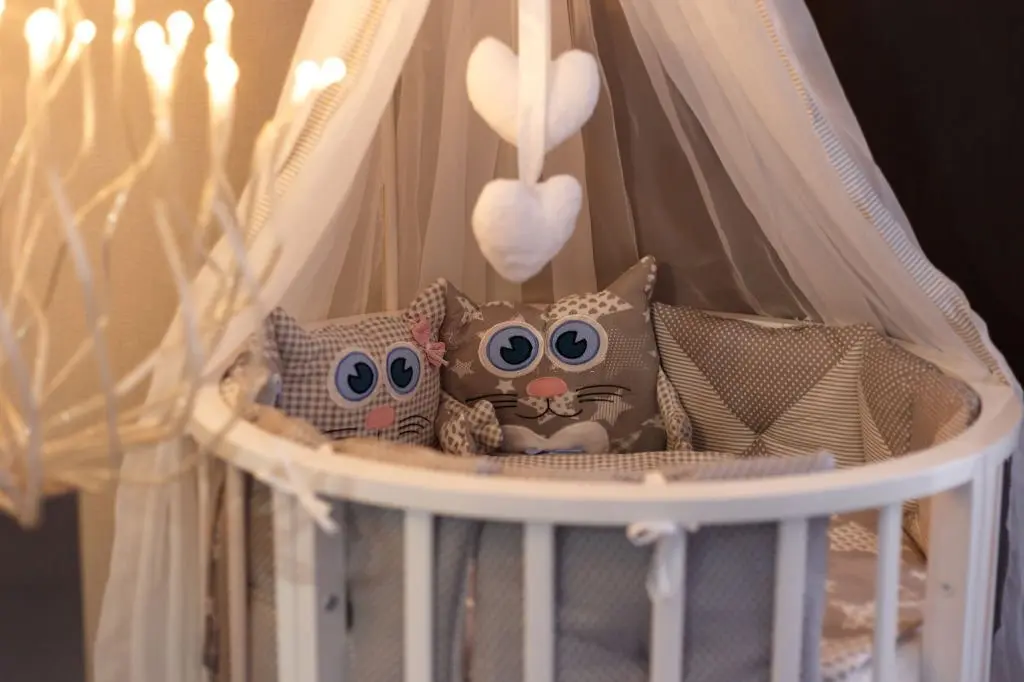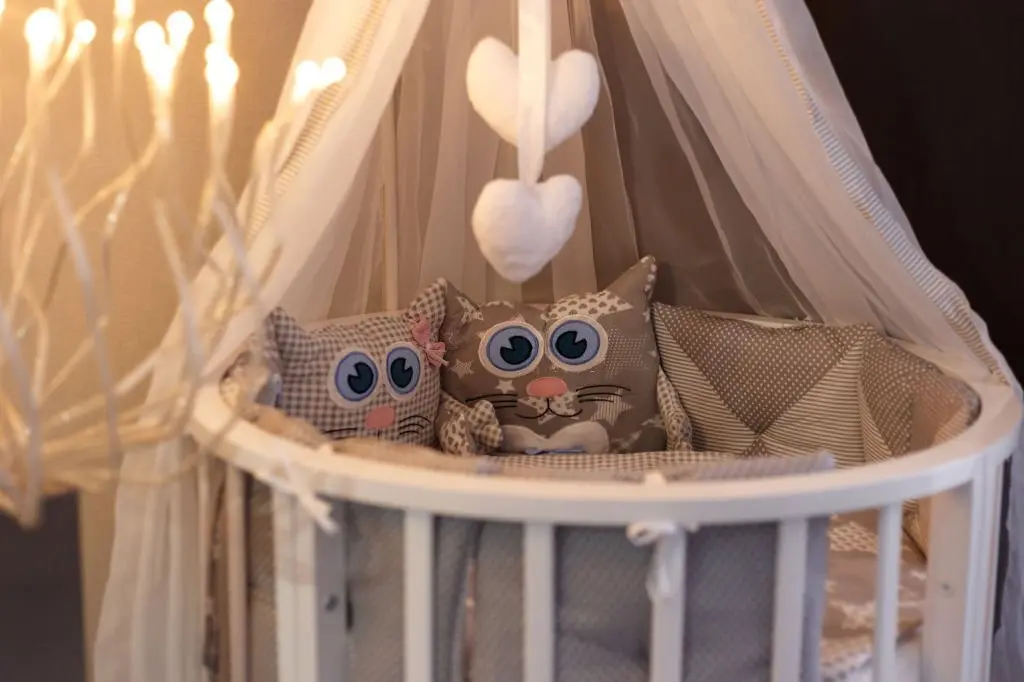Are Cribs Safe Without Bumpers? Exploring the Controversy

Introduction: Are cribs safe without bumpers?
Crib bumpers became popular in the 1950s when safety standards for crib slats were more lax. Wider spacing between slats allowed babies’ limbs to get stuck, so bumpers helped prevent injuries.
But modern crib regulations require slat spacing to be less than 2 3/8 inches. This makes the entanglement risk minimal in new cribs.
Are Cribs Safe Without Bumpers? The American Academy of Pediatrics says no – they recommend against using any crib bumpers due to the potential dangers.
Suffocation hazard
If a baby’s face presses against a cushioned bumper, they are at risk of suffocation or rebreathing exhaled air. This could lead to suffocation. Even a small gap between the bumper and mattress poses dangers. Infants lack the motor skills and strength to move their heads or push away from a suffocation hazard.
Their noses and mouths can become pressed against a soft bumper, blocking airflow. This is especially risky during the early months when babies sleep for long stretches and don’t regularly change positions. Suffocation can happen quickly and quietly. So padded crib bumpers, even when properly installed, present a constant suffocation risk.
Strangulation risk
Babies’ arms and legs can get stuck between bumper ties or in gaps between bumper and crib rails. Their limbs can slip into these narrow openings but become trapped when trying to pull back out. This can cut off circulation or restrict breathing by compressing their chest and windpipe.
Strangulation from bumper ties or gaps usually affects the neck, but can also involve arms or legs. Just a few minutes of restricted blood and oxygen flow can be fatal for infants. Strangulation is silent and often happens during naps when nobody is watching the baby. So crib bumpers pose a serious strangulation hazard even when parents follow installation instructions meticulously.
Entrapment risk
If babies work their way under loose bumpers, they may get trapped and unable to breathe. Infants lack the strength and coordination to push bumpers away from their faces once stuck underneath. Younger babies also haven’t developed the ability to roll over or reposition their bodies when in danger.
So a bumper that comes partially detached or slips lower down on the crib rails can easily cover a baby’s face, blocking airflow. Infants and young babies would be unable to escape from this life-threatening entrapment situation. Crib bumpers always carry a risk of becoming dislodged and creating a dangerous entrapment scenario.
These suffocation, strangulation, and entrapment risks all pose threats to babies’ safety when using crib bumpers.
Alternatives for safe sleep without bumpers
Many parents want to heed warnings but still have concerns about babies hitting the hard crib rails. There are some alternatives to provide protection without bumpers:
- Crib Tents – Mesh canopies that zip onto crib rails to make a see-through enclosure. Allow airflow but prevent limbs from poking out. Unlike bumpers, breathable mesh tents don’t obstruct oxygen flow to the baby’s face. Tents also fully enclose the crib so there is no risk of babies slipping under a loose edge. But they do maintain visibility and ventilation. The flexible mesh moves with the baby to avoid any suffocation points of contact. Crib tents zip closed so babies’ limbs stay safely inside. But the material is soft and won’t cause injury if rolled into. Crib tents offer physical protection without posing airway risks.
- Wearable Blankets – Sleep sacks or swaddles keep arms and legs contained to protect the baby from crib rails. A wearable blanket acts like a bumper by keeping a baby’s flailing limbs away from the hard crib edges. But it does so without hazards since their arms and legs are not constricted and their face and chest remain free of any obstruction. Sleep sacks also prevent unsafe loose blankets in the crib that could lead to suffocation or overheating. The enclosed sleep sack pouch safely holds babies’ limbs immobile. But their head remains unrestricted with full access to fresh air flow.
- Crib Rail Covers – Cushy foam covers slip onto crib rails like bumpers but don’t wrap all the way around. Avoid suffocation risk while protecting from hard surfaces. Crib rail covers cushion just the sides of the rails babies could impact during sleep. They differ from traditional bumpers by leaving large gaps rather than enclosing the crib perimeter. This eliminates suffocation and strangulation hazards. Babies won’t have their faces or limbs pressed against a soft surface. Gaps allow plenty of breathing room. Rail covers just soften direct blows from the rails. Like tents and sleep sacks, rail covers have an openness that bumpers lack. So they prevent concussive trauma but don’t obstruct airways.
- Breathable Mesh Liners – Mesh liners create an interior barrier but maintain ventilation. Not recommended but possibly safer than padded bumpers. While no evidence shows mesh liners are completely safe, they may have advantages over standard bumpers. Air can flow through breathable mesh so it poses less suffocation risk. Openings in the weave make strangulation from entrapment less likely. But any liner could still become dislodged. Mesh meets safety requirements better by optimizing airflow. But no bumpers or liners are considered fully safe. However, the mesh may be a compromise for guarding against limb entrapment with fewer breathing hazards.
Using alternatives allows you to create a safer sleep space without risky bumpers.
Creating a safe crib environment without bumpers

Avoiding bumper risks doesn’t mean you have to leave your baby unprotected in an empty crib. Follow these tips to create a safe sleep space:
Choose a compliant crib
Ensure your crib meets all current safety standards. Key features include:
- Slats spaced less than 2 3/8 inches apart – Widely spaced slats are a strangulation hazard if limbs get stuck. Regulation cribs have narrow slats that prevent entrapment.
- Snug-fitting mattress with no gaps along sides – Even small gaps allow limbs to slip into dangerous positions. A flush mattress also reduces rebreathing of carbon dioxide trapped near the crib bottom.
- Solid end panels without cutouts – Avoid decorative cutouts on end panels that can catch arms and legs. Solid flat ends keep little limbs safely on the mattress surface.
Buying a crib that meets CPSC and ASTM International standards ensures your crib itself won’t pose suffocation, strangulation, or entrapment dangers. Starting with a safety-compliant crib is crucial.
Use the correct mattress height
Adjust mattress positions as your baby grows so it remains flush with the top rail. No gaps should exist where limbs could slip through. Babies move down toward the crib foot over time. Ensure the mattress is always properly fitted.
A gap as small as an inch between the mattress and rails allows a limb to get stuck. This can lead to injury or loss of blood flow. Don’t use a crib mattress that is too small or place bulky pads underneath. And never use extra pillows or cushions. Proper mattress height removes the risk of dangerous limb entrapment.
Use proper bedding
Use tightly fitting bottom sheets. Avoid loose blankets and only use sleep clothing with no dangling ties or strings. Ill-fitting sheets can come loose and wrap around a baby’s face or throat. Lose blankets also pose a suffocation hazard.
Make sure sleepwear has no ties or loose pieces that can catch on crib parts and strangle tender limbs. Don’t use heavy quilts or comforters that can cause overheating. Proper bedding reduces injury and breathing obstruction risks.
Follow safe sleep guidelines
Recommendations like placing babies on their backs and keeping cribs bare can lower SIDS risks. Beyond bumpers, following all safe infant sleep guidelines gives your baby the safest possible sleeping conditions.
This includes room sharing without bed sharing, avoiding soft bedding, and not overdressing your baby. Safe sleep practices combined with a safe crib reduce the chances of suffocation.
Supervise your baby
Frequently check on your baby to ensure they remain properly positioned. Reposition as needed. Active babies can wiggle into hazardous positions.
Always place them on their back initially. But monitor their movement and correct unsafe positioning. Adjust loose bedding and re-center your baby away from crib edges. Active supervision prevents many crib injuries.
Conclusion: Are cribs safe without bumpers
Are cribs safe without bumpers? There are good arguments on both sides. Bumpers present real suffocation, strangulation, and entrapment hazards. But alternatives like crib tents and rail covers can provide protection without these risks.
Follow safety guidelines, supervise closely, and transition to a toddler bed when appropriate. Your baby can sleep soundly and safely, with or without bumpers. Work with your pediatrician to make the choice you feel most comfortable with.
Also Read:
- How to Prevent Baby from Getting Legs Stuck in Crib
- Is It Safe to Hang Pictures Above a Crib?
- Is a rocking chair good for nursery
- How Do You Hang Wall Decor in a Nursery
FAQs: Are cribs safe without bumpers
Is it safe for a baby to sleep in the crib without a bumper?
Yes, it is safe for a baby to sleep in a crib without bumpers. The American Academy of Pediatrics recommends against using crib bumpers due to the risk of suffocation, strangulation, and entrapment.
A bare crib is safest as long as it meets current safety standards, a properly fitting mattress is used, and safe sleep guidelines are followed.
What is a safe alternative to crib bumpers?
Some safe alternatives to provide padding without using traditional bumpers are crib rail covers, breathable mesh liners, wearable blankets like sleep sacks, and crib tents.
These maintain airflow and visibility while protecting against limbs getting stuck. But no padding product is considered as safe as a bare crib.
At what age are crib bumpers safe?
There is no age when crib bumpers can be considered completely safe. The American Academy of Pediatrics recommends against using padded bumpers at any age due to the risk of injury and death.
Once a baby can stand up in the crib, bumpers pose an added fall hazard. Some parents may choose thin mesh bumpers with careful installation, but these are still not endorsed as safe.
Do parents still use crib bumpers?
Despite safety warnings, some parents do still use crib bumpers. Those who are reluctant to give them up may opt for mesh rather than padded bumpers and install them very securely.
But the majority of parents today do choose to follow recommendations and use a bare crib. While bumpers offer perceived protection, most parents decide to prioritize safety guidelines. Thin breathable mesh liners are also a compromise some parents make. But bare cribs are considered safest.
